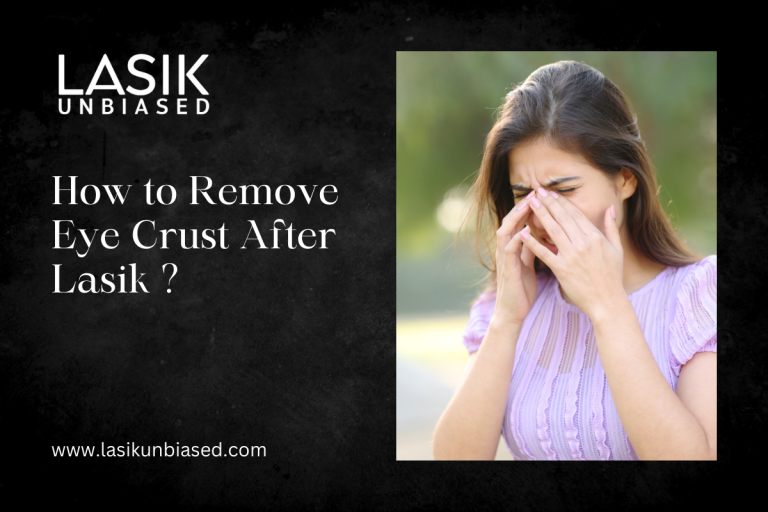LASIK (Laser-Assisted in Situ Keratomileusis) is a popular and effective eye surgery designed to correct refractive vision problems, such as myopia, hyperopia, and astigmatism. While LASIK significantly improves vision, recovery can be challenging for some patients. One of the common issues patients may experience after LASIK surgery is the formation of eye crust or discharge around the eyes. This can be uncomfortable, but it’s typically a temporary side effect and can be managed effectively with the proper care. This article will discuss removing eye crust after LASIK and offer helpful tips to ensure a smooth recovery.
Why Does Eye Crust Form After LASIK?
After LASIK surgery, your eyes undergo a healing process involving physical and physiological changes. Creating a corneal flap during the procedure can lead to some irritation in the eye, which may trigger an increase in tear production. This, combined with the natural healing process, can cause dried tears or discharge to accumulate around the eyes, leading to crusty buildup. This crust is generally a combination of dried eye fluids, dust, and other particles accumulated around the eye during healing.
While this discharge is normal and not a cause for concern, it’s essential to manage it properly to avoid any risk of infection or further irritation. Removing eye crust gently and safely is an integral part of post-surgery care.
How to Safely Remove Eye Crust After LASIK
The key to removing eye crust after LASIK is to be gentle and cautious, as your eyes are still healing. Here are some steps you can take to remove eye crust safely:
1. Wash Your Hands Thoroughly
Always wash your hands thoroughly with soap and water before touching your eyes or face. This helps prevent the introduction of bacteria, which could lead to infection, especially during the early stages of your LASIK recovery.
2. Use a Clean, Soft Cloth
To remove eye crust, use a clean, soft cloth or cotton pad that is gentle on the sensitive skin around your eyes. Avoid using rough materials that could irritate your eyes. Dampen the cloth with warm water, but do not make it too hot to prevent further irritation.
3. Gently Wipe the Eye Area
Press the damp cloth against the crusty area to soften the dried discharge. After a few seconds, gently wipe away the crust by moving the fabric in a very light, circular motion. Avoid applying any pressure to the eyes themselves. Repeat this step with a fresh cloth dampened with warm water if the crust does not come off quickly.
4. Use Sterile Eye Drops (If Recommended)
Sometimes, your ophthalmologist may recommend lubricating eye drops to help moisturize the eyes and dissolve any crust. These eye drops can help reduce dryness, irritation, and crusting around the eyes. Always use sterile eye drops that are prescribed explicitly for post-LASIK recovery. If you experience excessive crust or irritation, consult your doctor to ensure you use the appropriate drops for your condition.
5. Avoid Rubbing Your Eyes
Resist the urge to rub your eyes, as this can lead to further irritation and disrupt the healing of the corneal flap. Rubbing can also introduce bacteria and other particles, increasing the risk of infection. Instead, focus on using the gentle wiping method described above.
6. Consider Warm Compresses
A warm compress can help to soften the crust and make it easier to remove. Soak a clean washcloth in warm water (not too hot), wring it out, and place it over your closed eyelids for a few minutes. This can help loosen any dried discharge, making it easier to wipe away gently with a soft cloth or cotton pad.
7. Follow Your Surgeon’s Instructions
Always follow the aftercare instructions given to you by your LASIK surgeon. If your surgeon has provided specific guidelines for managing post-surgery symptoms such as eye crust, following them carefully is essential. If you are unsure how to remove the crust or have concerns about your recovery, contact your healthcare provider for guidance.
When to Seek Medical Help
While eye crust is generally harmless and can be easily managed at home, there are instances when it’s essential to seek medical attention. If you experience any of the following symptoms, contact your ophthalmologist immediately:
- Excessive pain or discomfort: If you experience severe pain, not just mild irritation, it could indicate an infection or other complication.
- Increased or greenish discharge: If you notice an increase in the amount of discharge or if it becomes thick and green, this could be a sign of an eye infection and requires prompt medical attention.
- Redness or swelling: Excessive redness, swelling, or discharge around the eye could indicate an infection or inflammation.
- Vision problems: If you experience significant changes in your vision, such as blurriness or halos, this could indicate a complication from the surgery.
While crust formation is usually not a cause for concern, your ophthalmologist should address any changes in your condition to ensure proper healing.
Tips for Preventing Eye Crust Formation
While it is expected to experience some crust around the eyes after LASIK, there are a few tips that can help minimize the occurrence of excessive crust:
- Keep Your Eyes Moisturized: Use lubricating eye drops as your doctor recommends to keep your eyes hydrated and reduce dryness, which can contribute to crust formation.
- Follow Post-Operative Care Instructions: Be diligent about following the aftercare guidelines provided by your surgeon. This includes avoiding rubbing your eyes, keeping the eyes protected from dust and debris, and attending all follow-up appointments.
- Sleep with Protection: If your surgeon recommends wearing protective eye shields during sleep to avoid accidental rubbing, wear them as instructed. This can help prevent irritation and the buildup of crust.
- Avoid Allergens and Irritants: Avoid exposure to dust, smoke, and other airborne irritants that can cause dryness and exacerbate crust formation.
- Stay Hydrated: Drinking plenty of water can help maintain eye moisture and reduce the risk of dryness, which can help minimize crust buildup.


